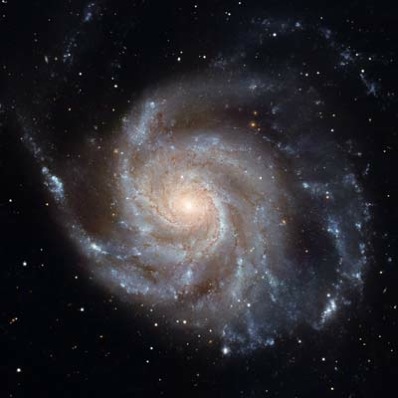



|

|

Was the big bang
born rotating?
by Amanda Doyle
for ASTRONOMY NOW
Posted: 08 July 2011


An excess of galaxies rotating in a counter-clockwise direction could imply that the Universe was created in a rotating big bang.
It is generally thought that the Universe should be isotropic and homogenous, meaning that everything should look the same in all directions. This also means that there should be an equal number of left-handed and right-handed galaxies. But using data from the Sloan Digital Sky Survey (SDSS), physicist Michael Longo and a team of undergraduates have found that galaxies are more likely to be “left-handed”; in other words counter-clockwise. The SDSS has observed hundreds of thousands of galaxies using the 2.5 metre telescopes at the Apache Point Observatory in New Mexico.

An excess of counter-clockwise galaxies, such as this Hubble image of M101, may indicated that the Universe was born spinning. Image: NASA, ESA, K. Kuntz (Johns Hopkins University), F. Bresolin (University of Hawaii), J. Trauger (Jet Propulsion Lab), J. Mould (National Optical Astronomy Observatory), Y.-H. Chu (University of?Illinois, Urbana), and the Space Telescope Science Institute.
“If the galaxies tend to spin in a certain direction it means that the overall Universe has a (large) net angular momentum,” Longo tells Astronomy Now. “Since angular momentum is conserved, it seems it must have been ‘born’ spinning.” In an isotropic and homogenous Universe, the big bang explosion should have been symmetrical. However, if the Universe was spinning it would create an axis, similar to the Earth’s rotation axis, which would influence the rotation of galaxies.
The big bang theory assumes that when the Universe was created there was nothing outside it. Therefore, for the big bang to be rotating when it occurred suggests that it was rotating relative to something. “The simple answer is that it was spinning relative to other Universes in some larger space,” says Longo. “We could never see outside of our Universe in principle, but if we could show that the present Universe still retains the initial angular momentum within its galaxies, it would be evidence that our Universe exists within some larger space.”
Longo claims there is a very slim chance that the over abundance of left-handed galaxies could be caused by something else. For example, galaxy collisions would not explain this as it “would cause no change in overall angular momentum.”
The study shows that galaxies as far away as 600 million light years all show the same phenomenon. “It would be extremely surprising to find a correlation of galaxy spins over such large distances, that did not encompass essentially the whole Universe,” says Longo.
However, further investigation still needs to be done as this survey mainly encompassed galaxies seen from the northern hemisphere. A similar survey in the southern hemisphere would show galaxies with a tendency to rotate clockwise if this theory is correct.
|

|

|

|
|



